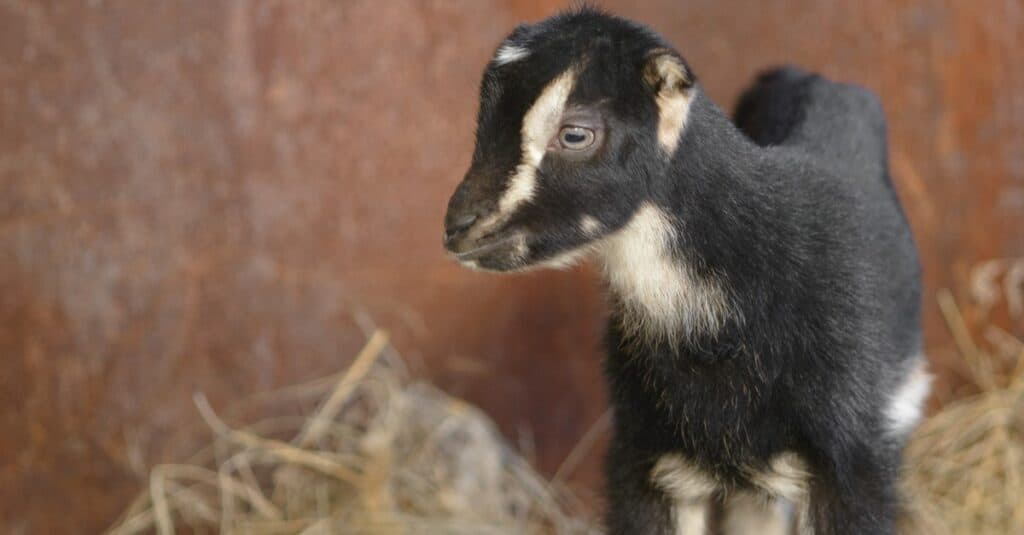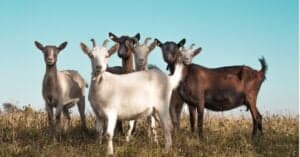When people picture goats, they usually imagine a pleasantly compact creature with a soft nose and floppy ears. Some goats, like the Nubian breed, are famous for their long, velvety ears. Because of this feature, they are often found in petting zoos. But a goat with no ears at all? Is that possible?
As strange as it sounds, this breed of a goat with no ears actually exists! Meet the LaMancha goat, a loveable breed with little to no external ear flaps. Below, you will find all you need to know about this curious animal.

LaMancha goats have distinctive short ears, referred to as either “gopher ears” or “elf ears.”
©Jonathan_Densford/Shutterstock.com
What Is a LaMancha Goat?
The LaMancha goat is a type of goat breed thought to originate in Spain. Its scientific name is Capra aegagrus hircus. Alternately, the LaMancha is sometimes called the American LaMancha. Its most distinctive feature is its minimal external ear flaps. The high quality of its milk and its docile, pleasant temperament have also made an extremely favorable impression on the farming community. It is considered the ideal choice for beginning farmers.
LaMancha goats stand between 2-3 feet high and tend to be broad in the body. Females typically weigh around 130 pounds while males average 165 pounds. They can be any common goat color including black, white, grey, brown, or reddish-brown. A black stripe along the back is typical.
Do LaMancha Goats Have Ears?
LaMancha goats do have ears, of course, or they wouldn’t be able to hear anything! However, the generous outer flaps that characterize most goat breeds are absent in the LaMancha. Instead, they have tiny nubs or diminutive elvish-looking flaps.
These two different types of ears are referred to as gopher ears and elf ears, respectively. In fact, as outlined below, there are strict standards about ear shape and length that these goats must meet in order to be officially registered as LaManchas.
Because their outer ears are so short and provide so little external protection, LaMancha goats are at increased risk for ear infections. LaMancha owners must take extra care to keep their ears clean and healthy.

LaMancha goats have sturdy, blocky bodies and can be any colour.
©souldust/Shutterstock.com
Official Breed Standards
The American Dairy Goat Association (ADGA) holds pure-bred LaMancha goats to a high standard with several restrictions on ear size. Official registration requirements differ slightly for males and females. Bucks, or intact male goats, are only permitted to have short gopher ears. The maximum length for this type of ear, male or female, is approximately 1 inch or 2.54 centimeters. There must be little to no cartilage. This restriction is in place for bucks to avoid passing down genes for longer ears, which could muddy the genetic waters.
Does, on the other hand, are permitted to have either gopher ears or elf ears. The standard for elf ears is somewhat different. A maximum length of 2 inches or 5.08 centimeters is permissible, along with a moderate amount of cartilage. The end of the ear must be turned down to give it its distinctive appearance. Any type of ear other than those already described is grounds for disqualification.
As for body size, bucks must stand a minimum of 30 inches or 76 centimeters at the withers with a minimum weight of 155 pounds. For does, the minimum height is 28 inches or 71 centimeters with a minimum weight of 130 pounds.
Any color or mix of colors is permissible in a registered goat. As for the facial shape, it must be long and straight.
The Disputed Origin of the LaMancha Goat
The origin of the LaMancha goat is disputed. Many sources claim that the breed was developed from goats brought over by Spanish missionaries from La Mancha, Spain, in the 1700s. These goats would have had the same small ears and tough frame the breed is known for today. However, others insist that the LaMancha has no ties to Spain and is purely American in origin.
In any case, the LaMancha is considered the only goat breed to have originated in the United States. A woman named Eula Fay Frey bought a dairy farm in California in 1937 for the purpose of raising goats for their milk. The herd came with a couple of short-eared goats. Frey was amazed to discover how much milk they yielded from a single milking. She began to breed them, crossbreeding them with other goats including Nubians and Alpines.
What emerged was the breed known as the American LaMancha. The American Dairy Goat Association first officially recognized it in 1958.
The Famous LaMancha Temperament

Lamancha goats have sweet, docile temperaments and make great pets.
©Abramoff/Shutterstock.com
LaMancha goats are renowned not just for their ears, but also for their temperament. While many goats can be snippy and stubborn, the LaMancha is known for being docile, sweet, and compliant. This makes them excellent farm animals.
However, they aren’t just used for milk and meat. LaMancha goats also make great pets, especially for children. They are generally a very healthy breed and do not need to be milked if the owners would rather not make the effort. Delightfully, they can also learn their names and come when called!
Some people even enjoy swimming with their pet goats. Although goats typically detest water, is it possible to acclimatize LaManchas with some effort and persistence. It is vital to ensure the goat is thoroughly dried off before leaving them outside afterward, as they chill easily.
If you consider keeping a LaMancha goat as a pet, remember that they are herd animals and will get lonely without at least one other goat around. A minimum of two goats is necessary to prevent depression and listlessness. When kept healthy and happy, they are intelligent, clever, and affectionate companions.
Some LaMancha goats are also shown in the ring. If this is the intended purpose, they must adhere to all breed standards.
Do They Give Good Milk?

LaMancha goats are prized for their milk production.
©ANGHI/Shutterstock.com
LaMancha goat milk is highly nutritious, which is the main reason Eula Fay Frey purchased the goat farm that eventually produced the standardized breed. Their milk is abundant in butterfat and nutrients, making it a good alternative to traditional cow milk. LaManchas also produce milk in large quantities and are long-term, steady producers.
Predators
Unfortunately, like any goat breed, the LaMancha can fall prey to wild animals. Common predators of the LaMancha include coyotes, wolves, bears, and mountain lions. Large birds of prey can attack young goats, or kids. A high, sturdy fence and guardian animals like border collies are vital to keeping the herd safe.
Despite having no ears, the LaMancha goat is a big-hearted addition to any farm or household with its sweet temperament and highly nutritional milk.
The photo featured at the top of this post is © ANGHI/Shutterstock.com
Thank you for reading! Have some feedback for us? Contact the AZ Animals editorial team.






